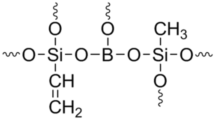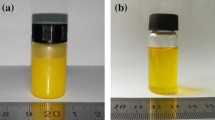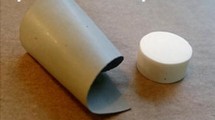Abstract
New silicon boron oxycarbide (SiBOC) preceramic polymers were synthesized via sol–gel method by using n-butyltrimethoxysilane and iso-butyltrimethoxysilane as silicon sources, triethylborate and boric acid as boron sources to obtain SiBOC ceramics. The effect of different molar ratios of Boron/Silica (B/Si) and ultrasonic application were investigated on gelation time. Influence of the microwave application on gelation time was performed for the first time, and compared with ultrasonic application. The changes in the structure of SiBOC preceramic with amount of boron, addition of glycerol, ultrasonic and microwave applications were also investigated by Fourier transform infrared spectroscopy, thermogravimetric analysis, X-ray diffraction technique and 29Si MAS NMR spectroscopy. It was observed that the gelation time (tgel) is reduced with higher amount of boron in the structure as well as ultrasonic and microwave application. Reduction of gelation time with increasing boron amount was related to formation of more Si–O–B (borosiloxane) bonds in the structure. Furthermore, decreases of gelation time with ultrasonic or microwave application may be owing to the acceleration of the hydrolysis and condensation reactions. Pyrolysis of obtained gels under nitrogen atmosphere up to 1,400 °C by 10 K/min heating rate produced solid homogeneous ceramic powders.

















Similar content being viewed by others
References
Colombo P, Mera G, Riedel R, Soraru GD (2010) Polymer-derived ceramics: 40 years of research and innovation in advanced ceramics. J Am Ceram Soc 93:1805–1837
Peña-alonso R, Mariotto G, Gervais C, Babonneau F, Sorarù GD (2007) New insights on the high-temperature nanostructure evolution of SiOC and B-doped SiBOC polymer-derived glasses. Chem Mater 19:5694–5702
Nagaiah NR, Kapat JS, An L, Chow L (2006) Novel polymer derived ceramic-high temperature heat flux sensor for gas turbine environment. J Phys 34:458–463 (International MEMS Conference)
Bharadwaj L, Dhamne A, An L, Kapat JS, Chow L (2003) Polymer-derived Si–Al–C–N–O ceramics for high temperature applications. Int Jt Power Gener Conf 5:607–611
Nagaiah NR, Krishnan V, Kapat JS, An L (2005) A conceptual design of a polymer-derived ceramic hot-wire anemometer for gas turbine environment. Power Land Sea Air 7:639–645
Mera G, Riedel R (2009) Organosilicon-based polymers as precursors for ceramics. In: Colombo P, Riedel R, Soraru GD, Kleebe H-J (eds) Polymer derived ceramics: from nanostructure to applications. DEStech Publications Inc, Lancaster, pp 51–89
Riedel R, Mera G, Hauser R, Klonczynski A (2006) Silicon-based polymer-derived ceramics: synthesis properties and applications—a review. J Ceram Soc Jpn 114:425–444
Sorarù GD, Babonneau F, Gervais C, Dallabona N (2000) Hybrid RSiO 1:5/B2O3 gels from modified silicon alkoxides and boric acid. J Sol–Gel Sci Technol 18:11–19
Gao Y, Mera G, Nguyen H, Morita K, Kleebe H, Riedel R (2012) Processing route dramatically influencing the nanostructure of carbon-rich SiCN and SiCBN polymer-derived ceramics. Part I: low temperature thermal transformation. J Eur Ceram Soc 32:1857–1866
Kleebe H, Blum YD (2008) SiOC ceramic with high excess free carbon. J Eur Ceram Soc 28:1037–1042
Liebau V, Hauser R, Riedel R (2004) Amorphous SiBCO ceramics derived from novel polymeric precursors. Comp Rend Chim 7:463–469
Schubert U, Hüsing N (2005) Synthesis of inorganic material. Wiley-VCH Verlag GmbH and Co. KGaA, Weinheim
Riedel R, Mera G, Hauser R, Klonczynski A (2006) Silicon-based polymer-derived ceramics: synthesis properties and applications—a review. J Ceram Soc Jpn 114:425–444
Zhang H, Pantano CG (1990) Synthesis and characterization of silicon oxycarbide glasses. J Am Ceram Soc 73:958–963
Gervais C, Babonneau F, Dallabona N, Soraru GD (2001) Sol–gel-derived silicon-boron oxycarbide glasses containing mixed silicon oxycarbid (SiCxO4-x) and boron oxycarbide (BC yO3-y) units. J Am Ceram Soc 84:2160–2164
Wang Q, Fu L, Hu X, Zhang Z, Xie Z (2005) Preparation and properties of borosiloxane gels. J. Appl. Poly. Sci. 99:719–724
Sorarù GD, Dallabona N, Gervais C, Babonneau F (1999) Organically modified SiO2–B2O3 gels displaying a high content of borosiloxane (B–O–Si) bonds. Chem Mater 11:910–919
Schiavon MA, Armelin NA, Yoshida IVP (2008) Novel poly(borosiloxane) precursors to amorphous SiBCO ceramics. Mater Chem Phys 112:1047–1054
Tsvetkova IN, Shilova OA, Shilov VV, Shaulov AYu, Gomza YuP, Khashkovskii SV (2006) Sol–gel synthesis and investigation of hybrid organic–inorganic borosilicate nanocomposites. Glass Phys Chem 32:218–227
Adnadjevic B, Jovanovic J, Potkonjak B (2013) A novel approach to the explanation the effect of microwave heating on isothermal kinetic of crosslinking polymerization of acrylic acid. Russ J Phys Chem A 87:2115–2120
Binner JPG, Hassine NA, Cross TE (1995) The possible rol of the pre-exponential factor in explaining the increased reaction rates observed during the microwave synthasis of titanium carbide. J Mater Sci 30:5389–5393
Peña-alonso R, Sorarù GD (2007) Synthesis and characterization of hybrid borosiloxane gels as precursors for Si–B–O–C fibers. J Sol–Gel Sci Technol 43:313–319
Siqueira RL, Yoshida IVP, Pardini LC, Schiavon MA (2007) Poly(borosiloxanes) as precursors for carbon fiber ceramic matrix composites. Mater Res 10:147–151
Sorarù GD, Campostrini R, Maurina S, Babonneau F (1997) Gel precursor to silicon oxycarbide glasses with ultrahigh ceramic yield. J Am Ceram Soc 80:999–1004
Karakuscu A, Guider R, Pavesi L, Sorarù GD (2011) Broad-band tunable visible emission of sol–gel derived SiBOC ceramic thin films. Thin Solid Films 519:3822–3826
Bai HW, Wen G, Huang XX, Han ZX, Zhong B, Hu ZX, Zhang XD (2011) Synthesis and structural characterization of SiBOC ceramic fibers derived from single-source polyborosiloxane. J Eur Ceram Soc 31:931–940
Guron MM, Wei X, Welna D, Krogman N, Kim MJ, Allcock H, Sneddon HLG (2009) Preceramic polymer blends as precursors for boron-carbide/silicon-carbide composite ceramics and ceramic fibers. Chem Mater 21:1708–1715
Devapal D, Packirisamy S, Sreejith KJ, Ravindran PV, George BK (2010) Synthesis, characterization and ceramic conversion studies of borosiloxane oligomers from phenyltrilkoxysilanes. J Inorg Organomet Polym 20:666–674
Iyoku Y, Kakimoto M, Imai Y (1993) In: Sakai M (ed) Advanced materials’93, III/B: composites, grain boundaries and nanophase materials. Elsevier, Amsterdam, p. 755
Yang KH, Woo AJ (1996) Solid-state 1H and 29Si NMR studies of silicate and borosilicate gel to glass conversion. Bull Korean Chem Soc 17:696–699
Acknowledgments
The authors gratefully acknowledge Scientific Research Projects Unit of Akdeniz University (2012.02.0121.006) for financial support.
Author information
Authors and Affiliations
Corresponding author
Rights and permissions
About this article
Cite this article
Gencer, A., Oksal, B.S. Synthesis and characterization of novel SiBOC ceramics: comparison of microwave and ultrasonic application on gelation time. J Sol-Gel Sci Technol 73, 171–180 (2015). https://doi.org/10.1007/s10971-014-3508-0
Received:
Accepted:
Published:
Issue Date:
DOI: https://doi.org/10.1007/s10971-014-3508-0




